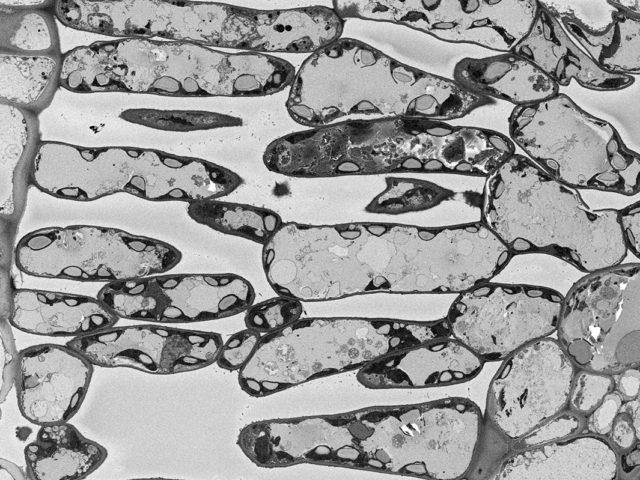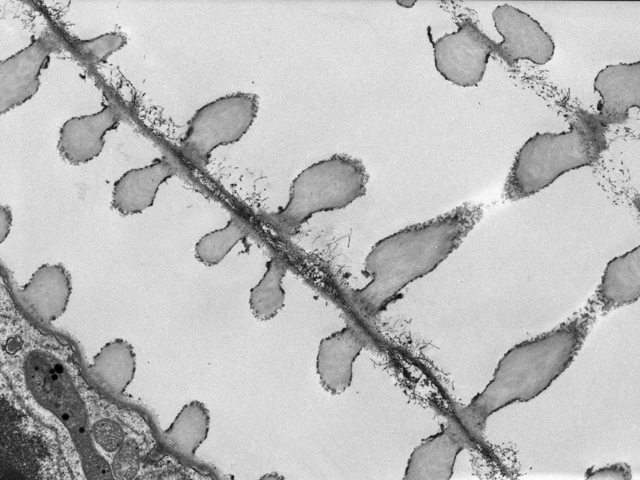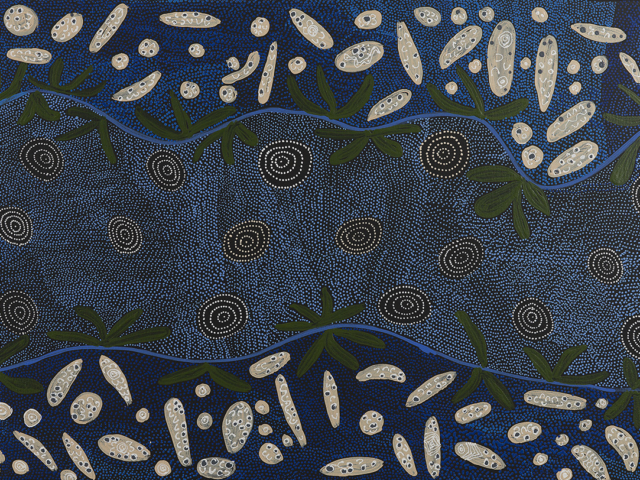River Red Gum LeafThe dome-shaped chloroplasts that line these leaf cells capture the sun’s energy to make sugars. These are stored as the white starch granules you can see inside the chloroplasts. That starch will help to fuel the growth of these magnificent trees. Some trees could be as old as 1000 years. River red gums live along water courses throughout Australia and play an essential role in Aboriginal life. River red gum leaves are used for smoking ceremonies (mantha in Gija) when welcoming new visitors on country. They can be used as a bush medicine, treating sores, colds and the flu. Plant water transport tubes (xylem).These tubes are the pipe system that transport precious water through plants from the roots to the leaves. The bumps protruding into the tubes are cross sections of rings that support and strengthen the xylem. As a tree grows, it produces more xylem and the older tubes form the heartwood of the tree. The thinner tube is around 4 micrometres in diameter (1 micrometre is one thousandth of a millimetre). Image: Anne Simpson |
Water DreamingThe country associated with this ‘ngapa Jukurrpa’ (water Dreaming) is Mikanji, a watercourse west of Yuendumu that is usually dry. There are ‘mulju’ (soakages) in this creek bed. The ‘kirda’ (owners) of this Dreaming site are Nangala/Nampijinpa women and Jangala/Jampijinpa men. Mikanji is an important water Dreaming site, and features in at least three different water Dreaming tracks. Artist: Lola Brown Additional stories A second water Dreaming track that passes through Mikanji is also owned by the Nangala/Jangala and Nampijinpa/Jampijinpa Subsections, and travels further west. At Mikanji, the storm rained so hard it created a hole in the ground which became a soakage. At Mirawarri a ‘kirrkarlanji’ (brown falcon [Falco berigora]) picked up the storm and carried it on its wings to the west until it became too heavy for it. The falcon eventually dropped the storm at Pirlinyarnu (Mt. Farewell) about 165 km west of Yuendumu, where it formed an enormous ‘maluri’ (claypan). A ‘mulju’ (soakage) exists in this place today. A third Dreaming track that passes through Mikanji is the story of the water Dreaming and ‘pamapardu Jukurrpa’ (termite Dreaming). This Dreaming travels further north. This water Dreaming is owned by Nakamarra/Napurrurla women and Jakamarra/Jupurrurla men. The termite and water Dreamings travelled together from Warntungurru in the east past Warlura (a waterhole eight miles east of Yuendumu), Wirnpa, Kanaralji, Ngamangama, and Jukajuka. A portion of this Dreaming track also includes the ‘kurdukurdu mangkurdu Jukurrpa’ (children of the clouds Dreaming). The termite Dreaming moved on to the west to Nyirrpi, a community approximately 160 km west of Yuendumu, whereas the water Dreaming travelled on to Mikanji. A ‘kirrkarlanji’ (brown falcon) eventually picked up the water and tied it to its head using hairstring. The falcon travelled north with the water Dreaming; at Puyurru, it flew under a tree and the water fell off of its head, forming a soakage there. The Dreaming then travelled on through other locations including Yalyarilalku, Mikilyparnta, Katalpi, Lungkardajarra, Jirawarnpa, Kamira, Yurrunjuku, and Jikaya before moving on into Gurindji country to the north. |





